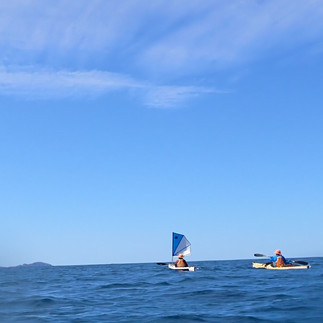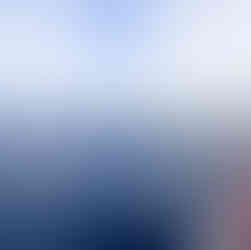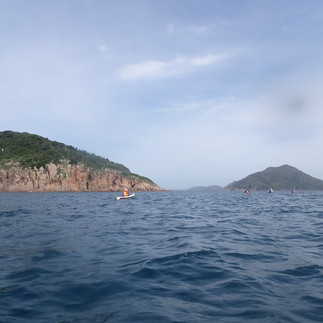
Day 1
I joined seven other paddlers on a three-day offshore kayak trip. We paddled from Jimmey's Beach, Hawks Nest, out to Broughton Island, a 20km journey.
We spotted a whale just outside the entrance to Port Stephens. I missed the breach but managed to snap an image of the tail.
Broughton Island is around 14km north of the entrance to Port Stephens. It is part of the Myall Lakes National Park. At around

3km long, 2km wide, and 132ha in area, it is not a big island yet is the largest continental island off the NSW coast. Broughton Island is the only place in NSW where it is permissible to camp in an active seabird colony. It is a popular spot for sea kayakers, fishermen/women, and nature lovers. It is home to many bird species, particularly the wedge-tailed shearwater which nest on the island between September and May each year. These are migratory birds that travel far and wide to places such as Antarctica, Siberia, Japan, South America, and New Zealand.
Broughton has an abundance of sea life with a large area around the island being protected from commercial and recreational fishing. Camping on the island is a unique experience, particularly during shearwater nesting season. Parent birds hunt for fish during the day and fly back onto the island at dusk to feed the hungry chicks. Feeding literally goes on through the night with the youngsters crying out with a sound akin to human babies. When thousands of them are crying at once it is a formidable sound! And guaranteed to disrupt sleep.

Day 2
After a night of being serenaded by wailing shearwater chicks, we woke to a beautiful clear day. At 9 a.m. we set off for our anticlockwise circumnavigation of the island.
The photos show us setting off, drifting in and out from cliffs and caves, another close whale encounter, and Rob surprising a group of seals relaxing in the morning sun. As he passed, you could almost hear them saying to each other "what the f#*! was that?" before immediately rolling back into their leisurely flotation.
We were able to paddle into some of the island's many caves. When conditions are calm enough it is possible to paddle all the way through Cons Cleft on the southeastern rocky peak known as Looking Glass Isle. The single picture below shows Rob inside the northeastern opening. Looking at how he is dwarfed by this magnificent cavern, it is sobering to think that in big swells, waves funneling through the cleft often explode up into the roof of this stone cathedral (as they were the following day.)
A companion on this trip Bob ('the Don'), who has traveled extensively, reckons the coastal rock formations around Broughton Island rival some of the best in the world. The pictures don't do justice to the grandeur and harsh majesty of the place. To me, this island coast looks like an ancient island fortress should look when it has spent countless millennia being battered by huge and violent seas.

History
Until recently, the pre-European history of the island had not been extensively detailed. A study that is currently being undertaken in conjunction with the University of Sydney is shedding light on its more ancient history. The Port Stephens and Myall Lakes region has been home to the Worimi people for tens of thousands of years. They would have walked and hunted the lands that included Broughton before it became an island. The seas rose somewhere between 9000 to 6000 years ago, and thereafter the traditional owners visited the island by canoe.
No doubt it would have been an important fishing and hunting ground. There is recent evidence that the aboriginal people used Broughton Island to make many of their stone tools, as rocks on the island show evidence of this industry. It is estimated that just before European settlement, there were around 600 Worimi people living in the region of what is now Port Stephens.
The area was surveyed by Commander William Broughton in 1795, and Broughton Island was named after him in the mid-18th century. Europeans started settling in the region from 1826. By the 1870’s, it was estimated that the indigenous population had decreased by at least 50%.
Fishing
Chinese and later Italian fishers worked the waters around Broughton Island from the mid-1800’s. By the early 20th century professional fishing commenced in the region. In the 1930’s,

huts were built by fishermen in what is now known as Esmeralda Cove. They exist to this day, having been maintained, improved, and added to. In 1972 the island was gazetted as part of the Myall Lakes National Park. In the 1980’s, National Parks and Wildlife proposed removal of the huts which by then had been used by some families for up to five generations. The owners lobbied the government, arguing that the huts were a haven for seafarers needing shelter from extreme weather. They also argued that the hut's owners had played a role in assisting NPWS in the protection and care of the island. They were allowed to remain, and NPWS now has a hut stationed at Esmeralda Cove alongside the fishing huts.
Feral Animals
From 1905 to 1907, Broughton Island was used as a testing ground for the biological control of rabbits by French-based Polish biologist Jean Danysz. The experiment was a failure, and the island was left to become overrun by the feral species. Then, in the 1930’s, black rats were introduced to the island, most likely by visiting fishing boats. The rabbits wreaked havoc on the island's vegetation with some plant species driven to extinction. The rats decimated certain animal species including the nesting bird populations. The wedge-tailed shearwaters (‘muttonbirds’) were greatly affected as they nest in burrows in the ground. The white-faced storm petrel population was driven off the island by the rats and has not returned to this day.
From around 2004 a plan was hatched to eradicate rats and rabbits from the island. The programme was commenced in 2009 and involved the release of the rabbit calici virus followed by baiting of the rabbits and rats. Later, springer spaniel dogs were used to detect any remaining rabbits, and none were found. In 2011 the island was declared feral free. Since then, vegetation on the island has thrived, and shearwater nesting numbers have grown rapidly. At the peak of the breeding season, it is estimated that tens of thousands of nests are present.

Day 3
The last day of our trip was devoted to packing up and heading home. It takes around an hour to pull down the campsite, pack all the gear, and stow it in the kayak hatches. We launched around 9.45. We paddled into a mild southerly headwind on the way back to Port Stephens. Though not strong, it was enough to keep the group's average speed to around 5km/hr, so it was a four-hour paddle back to the cars.
I had launched from Shoal Bay. Retrieving the car, unloading then washing down the kayak, and packing the car had me setting off for home at close to 2.30 pm. Hitting Hexham then Sydney peak hour meant I wasn’t home till 6 - a 10-hour day all up. But it was all well worth it. This was my fourth Broughton trip, and I never get tired of it.
References
httpswww.newsofthearea.com.austinkers-history-amazing-finds-on-broughton-island










































































Commenti